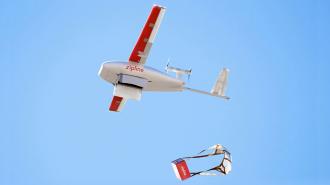Walmart is now using delivery drones to get products to customers in Arkansas — and if this project goes well, we could one day see drones rapidly delivering packages across the U.S.
Why it matters: When the pandemic hit, people started buying more of their food and goods online rather than venturing into stores for them.
That led to a more than 30% increase in ecommerce sales between 2019 and 2020, and there’s little to suggest we’ll see a major decline anytime soon.
The challenge: The most complicated part of the online fulfillment process is the leg of a product’s journey that brings it directly to a customer’s doorstep.
That “last mile” typically requires a driver in a fossil fuel-powered vehicle to hand deliver a package, and if a customer lives in a rural or remote area, their delivery can take significantly longer (or cost more) than in more populated areas.
The idea: Delivery drones sound a little scifi, but in some ways, they may be a better solution for last-mile logistics. Electric drones are faster and don’t produce carbon emissions, so they’re less polluting than gas-powered delivery trucks (although many delivery companies are starting to transition to electric vehicles).
Because they aren’t beholden to roads, delivery drones don’t contribute to or get stuck in traffic congestion, and they can fly directly to customers in rural or remote areas, cutting down delivery times.
The drone will then drop the package, with a parachute to slow its descent, at the customers’ home within 30 minutes of Zipline receiving an order.
What’s new: Despite being hyped for years, delivery drones have yet to really take off in the U.S. — they’ve delivered a burrito here, a Slurpee there, and the occasional organ, but we haven’t seen anyone demonstrate that they could be a legitimate part of the future of deliveries.
This Walmart project could change that, as it combines the world’s biggest retailer with a proven drone delivery company — Zipline delivery drones have made more than 200,000 commercial drops.
How it works: Walmart’s new delivery service will focus on the area around its Neighborhood Market in Pea Ridge, Arkansas. Initially, only “eligible customers” will be able to use the service (Walmart doesn’t explain who qualifies) and only for certain wellness and food items.
After a customer places an order and chooses a delivery time via the Zipline app, a Walmart employee will pack up the items and hand them over to a Zipline staff member. They’ll load the package into a delivery drone and launch it on a platform behind the store.
The drone will then drop the package, with a parachute to slow its descent, at the customers’ home within 30 minutes of Zipline receiving an order, before returning to the Walmart.
The big picture: Zipline’s drones are accurate enough to land a package within an area about the size of two parking spots, company officials told Axios. Zipline is able to launch a drone every 90 seconds, and each is capable of carrying a 4-pound package (hence, the item restrictions) up to 50 miles away.
Right now, though, Walmart’s delivery service will be in a more limited range, and the delivery drones will only be able to fly during daylight hours — that’s the deal the company was able to work out with the Federal Aviation Administration (FAA).
Truly, we might be headed toward a future in which fleets of delivery drones are criss-crossing the skies at all hours of the day and night.
Eventually, the FAA might give Walmart permission to fly farther and at more times, depending on how this trial goes. Truly, we might be headed toward a future in which fleets of delivery drones are criss-crossing the skies at all hours of the day and night — but first, officials need to work out all the regulatory kinks.
“The bottleneck is the regulatory framework,” Milind Dawande, a professor of operations management at the University of Texas, told TIME. “There are federal laws, there are going to be state laws, there are going to be city laws.”
“Of course, technology is improving every day, but the regulatory framework, how quickly it reaches maturity, will certainly determine how widespread and how fast [drone delivery] will be adopted,” he added.
We’d love to hear from you! If you have a comment about this article or if you have a tip for a future Freethink story, please email us at [email protected].






